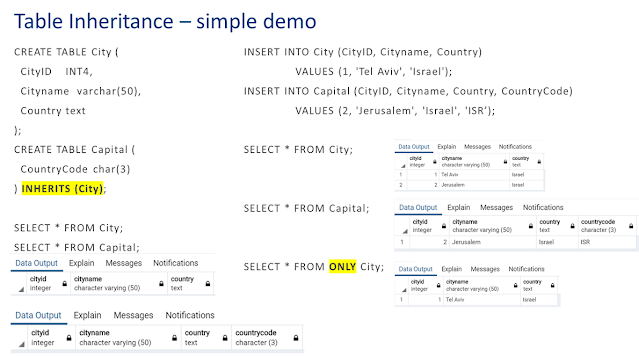“Standard” types
- numeric, floating-point
- string
- Boolean
- date/time
- UUID
- Universally Unique Identifies.
- 16 bytes of storage.
- Example: d5f28c97-b962-43be-9cf8-ca1632182e8e
- XML
- XML type is just a text data type.
- The advantage is that it checks that the XML is well-formed.
- json, jsonB
- Text Search Type:
- Two data types which are designed to support full-text search.
- Money
Special Data types
- Network Address
- Network information like IP address.
- Using Network Address Types has following advantages
- Storage Space Saving
- Input error checking
- Functions like searching data by subnet
- Geometric
- Represent two-dimensional spatial objects.
- They help perform operations like rotations, scaling, translation, etc.
- Enumerated
- A set of values.
- While inserting, it checks that the value is from the declared set.
- The ordering of the values in an enum type is the order in which the values were listed when the type was created.
- Example:
- ('sad', 'ok', 'happy’);
- In this example: ‘ok’ > ‘sad’ and < ‘happy’.
- Range
- Data in ranges.
- Can be a range of numeric and dates.
- Pseudo-Types
- special-purpose entries.
- Any, An array, Any element, Any enum, Nonarray, Cstring, Internal, Language_handler, Record, Trigger.
Custom data types - Composite Types
PostgreSQL user has the ability to create his own data types based on existing ones (composite types, ranges, arrays, enumerations).
CREATE TYPE inventory_item AS (name text, id integer)
SELECT item.name FROM on_hand WHERE item.price > 9.99;
INSERT INTO mytab (complex_col) VALUES((1.1,2.2));
UPDATE mytab SET complex_col = ROW(1.1,2.2) WHERE ...;
More about PostgreSQL data types: https://www.guru99.com/postgresql-data-types.html




